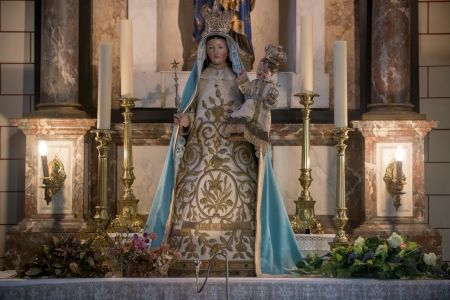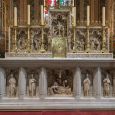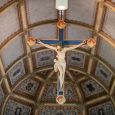Beguinage | 1599 | Gothic | Catholic Church



Map
Opening hours
01 June - 30 September
Mon -
Tue -
Wed -
Thu -
Fri 14.00 - 17.00
Sat 14.00 - 17.00
Sun 14.00 - 17.00
Guided tour
Book in advance via the culture and tourism department:
Grote Markt 35, 2200 Herentals +32 14 21 90 88 toerisme@herentals.be
Religious offices
Description
The church was completed in 1614, as one can see mentioned on the cramp-irons attached to the west facade.Much of the stones of the old beguinage were reused for the build. For the foundations, one didn’t just reuse the whether or not broken or whole bricks from the old beguinage, but one also made use of rubble iron from the region. The ascending masonry consists of brickwork, using white natural stone (Gobertange) for the baseboard, striped facades, door frames, and capstones. Where the stripes on the facade were being interrupted, one chose to complete them by using a layer to imitate the original look.
When entering the church, the neo-Gothic painting immediately catches one’s attention. Before 1874, the interior was whitewashed on a regular basis, about every ten years or so, sometimes with a touch of litmus (mauve). Nevertheless, a modest mural was found behind the altar of Saint Joseph (southern transept), which presumably dates back from the very beginning, possibly from the year 1599. In 1874, the current choir painting was made by Joseph Van Aerschot. Simultaneously, the choir windows were reshaped to match a neo-Gothic style and were decorated with stained glass windows.
KIKIRPA : photo-library online
Brochure "Historische stadswandeling"
Photos
Remarkable elements
Confessional
The rare early baroque confessional that one can see next to the entrance dates from 1634. Strangely enough, this confessional box also comes with a toilet, presumably a nineteenth-century rebuild of an earlier type of foot warmer, a heating device that worked on charcoal or with a heated stone.
Pulpit
A masterpiece is the pulpit, with the figures representing faith, hope, love, and innocence that one can see underneath the tub, and the symbols of synagogue and church at the bottom of the stairs. In 1680, Jacobus Verbuecken created the pulpit, while Peter Verbruggen created the beautiful sculptures, assisted by his two sons Peter and Hendrik Frans.
Cast iron fence
A striking decorative element is the neo-Gothic cast iron fence of the room that would be reserved in the past for the beguines, which was delivered in 1879 by August Van Aerschot, to add to the already existing fence that was previously created by him in 1846 in a more empire-like style.
Christ on the Cold Stone
On the outside of the church, in the southwest corner, one can see an aedicula with a wooden statue of Christ on the Cold Stone, dating from the early eighteenth century. The statue is decorated with a (new) lead cloak. At the height of the south transept, underneath a shelter, one can see a mural of Christ on the Mount of Olives. The largely faded painting (already mentioned in 1616), was recreated in 1958 by the artist Kallist Fimmers.
Main altar
A high quality neo-Gothic work of art, is the main altar created out of marble and alabaster. It was in 1889 that the altar was created by the artist Pierre Peeters from the city of Antwerp. Albrecht Jacobs delivered the copper tabernacle door, then the altar was decorated next with copper decorations by the artist Lambert Van Ryswyck from the city of Antwerp. Pierre Peeters was also the maker of the wooden statue of Saint Gerard Majella in 1898.
Church interior
The church interior holds a lot of valuable pieces. From the old church remains the cavalry group underneath the pier arch. The crucified Christ and John are from the sixteenth century, while the statue of Mary might be more recent. The cross itself and the painting are neo-Gothic. In the choir, one can also see a late Gothic copper chandelier with Mary with a halo from the sixteenth century. A tiny stone statue of the Holy Catherine from the late fifteenth or early sixteenth century is displayed in the niche above the entrance door.


































